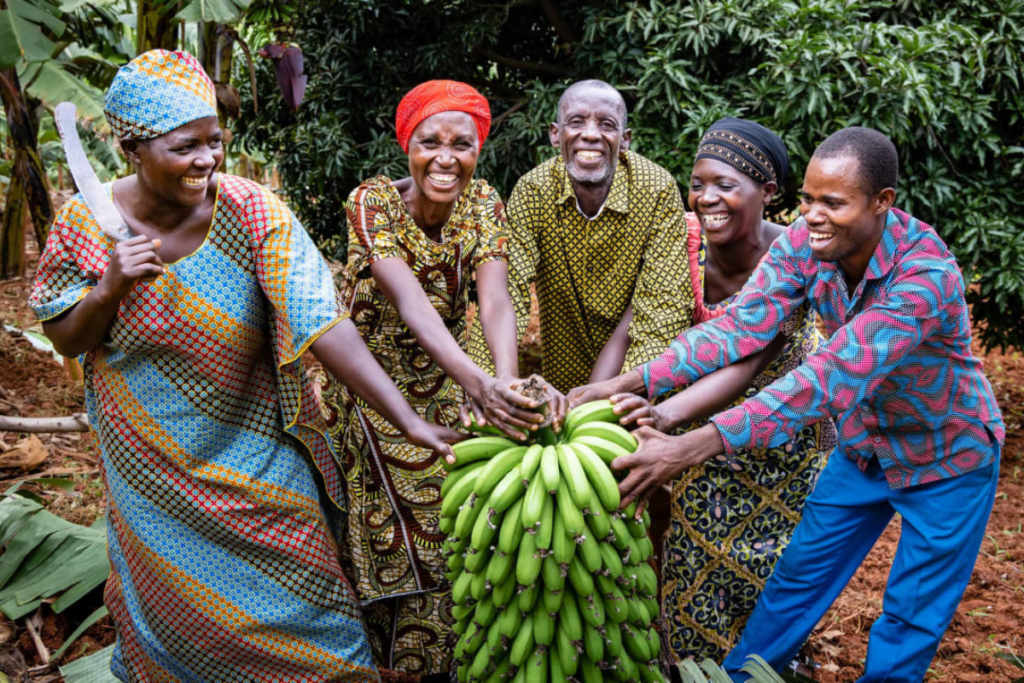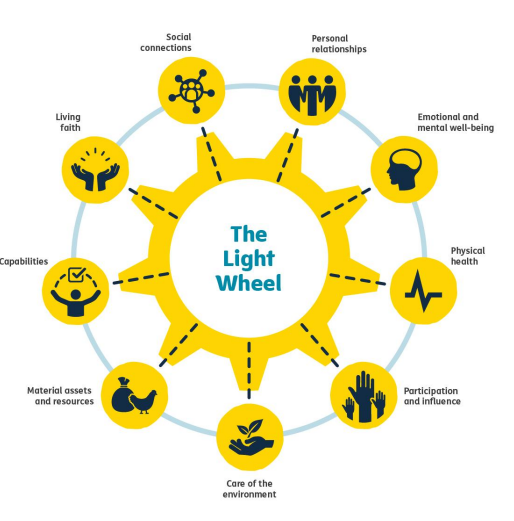Measuring and valuing wellbeing cross-nationally: Tearfund’s ‘compelling, credible and consistent’ impact
Christian relief and development agency Tearfund has worked with local churches around the world for over 50 years to bring transformational change to communities and reduce poverty. They call this model of working Church and Community Transformation, or CCT.
In this practice example Catriona Dejean, Director of Strategy and Impact at Tearfund, and Rose Fawcett, research consultant at State of Life, explore learnings and insights from their experience of conducting the charity’s largest ever social value impact assessment.
Wellbeing-informed social cost-benefit analyses like Tearfund’s can shed light on the social value of interventions and enable comparisons to the costs of programmes and policies.

Members of the Zizu community in Rwanda harvesting bananas from the plantation they set up through their church-based training group. Photo: Marcus Perkins / Tearfund
What did you do?
Tearfund’s Church and Community Transformation, or CCT, process is a Bible-based guided training approach that a local church can use with its community to identify the resources they have – working together to create long-lasting, whole-life change. As local communities work through the process, they decide what outcomes and activities work best in their situation. For example, this might be running training on vocational skills, establishing community projects, or setting up support and savings groups.
We know from research studies and from the stories shared with Tearfund by the communities we have worked with that CCT is making a powerful difference. But we wanted to measure the scale of the impact CCT has on people’s lives and the value of the transformation communities are experiencing.
In 2022, we worked with independent evaluation and social value specialist, State of Life, to generate rigorous evidence testing the hypothesis that CCT leads to improved wellbeing and reduced poverty for individuals, church congregations and communities. This is the first year of a pioneering multi-year study, which is the largest independent impact study Tearfund has ever embarked on.
We successfully surveyed almost 8,000 people across four countries (Rwanda, Sierra Leone, Tanzania and Zimbabwe) using a 15 minute long survey (see Appendix 11) focused on four domains of wellbeing (economic, personal, social and spiritual). We compared results for people actively involved in CCT activities with others in their wider community, and with people in communities where CCT was not taking place.
We achieved a well-matched demographic sample of CCT communities and communities where CCT has not started. Our control communities had been selected to start CCT in the near future but had not started the process at the time of data collection. Random sampling was used to identify 230 communities in total – 201 CCT communities and 29 control communities across the four countries. Stratified sampling was used within communities. The random sample was checked to ensure each country’s sample represented the spread across local partners, districts, how far through the CCT process the churches were (CCT stage), and how long the churches have been engaging in CCT (CCT maturity).
Our use of cross-sectional regression analysis allowed us to explore the difference in people’s lives associated with CCT once other factors such as age, gender or education level are taken into account.
What went well?
Our approach produced evidence of compelling, credible and consistent impact, with several methodological successes.
Evidence from a large and consistent sample
Using random sampling of communities yielded a well-matched sample between CCT and control communities, and representative of CCT communities at various stages of the process. Combined with the robust sample size achieved, it gave us confidence that the results generated were credible. As a result, we have been able to communicate these results widely.
This confidence was bolstered by the consistency in the findings. This consistency relied on the wide range of measures incorporated in the study. Not only did we find evidence of higher life satisfaction, but more positive outcomes for the other 22 wellbeing measures we included.
Because of our robust sample, we were able to test aspects of Tearfund’s Theory of Change for CCT work. Again we found consistent results, which were in line with the existing evidence base: higher wellbeing was associated with participation in CCT, especially among those participating for longer and more frequently.
The Light Wheel: compelling evidence of holistic wellbeing
Our research was heavily inspired by Tearfund’s Light Wheel tool. This was developed to understand, achieve and measure holistic wellbeing. It has nine spokes, which represent different aspects of wellbeing. We believe that transformation in each of the Light Wheel’s spokes is the basis for a full and flourishing life. The Light Wheel is used by communities participating in CCT as well as by Tearfund’s partners and development practitioners.

We drew upon seven spokes of the Light Wheel to create 23 wellbeing measures, providing a holistic picture of wellbeing across economic, personal, social and spiritual domains. The outcomes included life satisfaction as our key indicator of wellbeing. Two Light Wheel spokes were not included due to questionnaire length and to focus on the spokes where we had the best likelihood of capturing impact, based on the existing evidence base.
As far as possible, the questions used came from validated question sources including the World Values Survey and the International Social Survey Programme, to maximise the possibility of comparisons to other data sources. Working with Tearfund’s UK and country teams, some of the language was simplified to increase understanding across different cultures in the context of the African continent and to ease translation.
The results are compelling: we found higher life satisfaction and wellbeing (across all outcomes) in CCT communities than in control communities.
The WELLBY: a credible and pioneering method of social value measurement
In order to understand whether the investment in CCT by Tearfund and communities is worthwhile, we calculated social value using a wellbeing approach, in line with our focus on wellbeing through the Light Wheel. This was for the benefit of our own learning but also to articulate the value of CCT to our stakeholders such as communities, partners, supporters, donors, and policy-makers.
To do this, we used the WELLBY approach, outlined in the HM Treasury Green Book supplementary guidance on wellbeing to calculate the social value associated with participation in CCT: the value of the increased wellbeing, per individual and per community. We also calculated the net social value, taking the costs of CCT into account.
WELLBY is short for ‘Wellbeing-adjusted Life Year’. It is defined as a change in life satisfaction of one point on a scale of 0-10, affecting one person for one year. To make social value measurement possible, a WELLBY is given a monetary value. When social value is weighed against the costs invested, we are able to calculate the social return created by an intervention.
We believe that this research is the first time the WELLBY methodology has been used in African contexts. In the UK context, the WELLBY is valued at £13,000, according to HM Treasury guidance. We converted this valuation rate proportionally to median earnings across our four study counties into an appropriate value of £750. Costs were then accounted for, including volunteer time and the value of resources mobilised by communities themselves. Finally, a Social Benefit-Cost Ratio of the CCT process was conducted. To find out more about how we applied and adapted the WELLBY method, see this blog.
The results showed that the value of life satisfaction well exceeds all the resources, time and money invested in the CCT process by Tearfund, partners, facilitators and communities by as much as 28 times. This is an incredible social return.
For more information on the results of our research, see this blog or the full technical report.
What would you improve?
As this is the first year of a multi-year research study, we have the opportunity to apply lessons learned for the second year of the study. We plan to:
- Add more questions to the survey to include the remaining two Light Wheel areas of wellbeing: physical health and environment
- Add an additional research question to examine the impact of CCT on the local church itself, important for understanding sustainability.
- Ensure that all country teams implement the same data collection strategy, in particular a standardised approach to sampling non-participants in CCT communities. This will allow greater cross-country comparison.
Recommendations for others
The research has confirmed to us that CCT brings positive whole-life transformation, which is sustained and far-reaching and is great value. We are sharing the findings with church leaders, partners, policy makers, academic networks and journals, and donor communities. The evidence and the methodology applied present insight and learning for the wider international development sector, as well as thought-leadership to the different networks we are part of. We are also actively sharing the results back with community members who were part of the survey in the four countries. This is in line with our ethos and ethics to ensure inclusion and ownership of data by all.
Based on our learnings, we have two further methodological reflections for wellbeing practitioners to consider when conducting research in their context:
- Our innovative approach to social value measurement raises the question of whether the relationship between money and wellbeing found in the UK is true in other contexts and at different income levels. The availability and analysis of large national datasets of both income and life satisfaction is needed to fully examine this. Find out more about this.
- We acknowledge the tension between a standardised approach to measuring wellbeing, and contextualisation for each country and its specific approach to working with churches. This will be the case for many organisations with contextualised programming, requiring a careful balance of diversity of model, context and lived experience with comparability.
Question & Answer
What is social value measurement?
Social value measurement aims to put a monetary value to costs and benefits that do not have a market price, such as improved quality of life, increased trust in our neighbours, or an improved natural environment. Measuring social value (also called ‘social return’) helps us to understand the broader impact of CCT, and to quantify the intangible effects on someone’s life of increased life satisfaction and wellbeing.
In this study, we have sought to put a monetary value on the impact of CCT on people’s life satisfaction using the WELLBY approach.
Were church members the only people to benefit?
No – the benefits spread widely into the community – improvements to wellbeing were felt whether individuals attended church and its programmes or not.
Individuals who did not participate themselves still had better outcomes for 21 out of the 23 areas surveyed.
Everyone in the community, whether church members or not, could take part in the programmes – Tearfund works through local churches but people of all faiths and none are invited to participate.
Rose Fawcett is a research consultant at State of Life, which helps organisations (large and small) to measure their social impact and economic value and are named advisors in HM Treasury Guidance on measuring wellbeing. Rose holds an MSc in Economics and Econometrics and has previously worked in the international development sector.
Catriona Dejean is the Director of Strategy and Impact at Tearfund, leading the organisation’s strategy, research and impact agendas. Catriona brings over 20 years’ experience across the private, public and NGO sectors in the UK, Latin America, Europe and Asia. She currently serves on the INTRAC Board.

